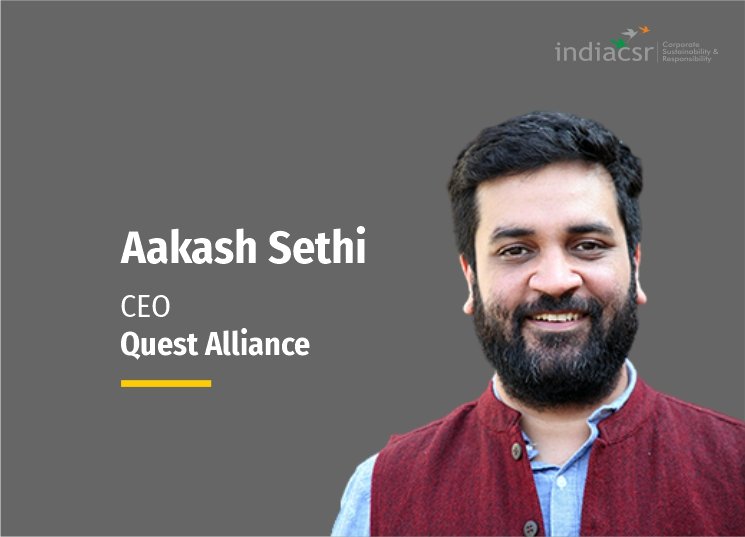In conversation with Rusen Kumar of India CSR, Aakash Sethi, CEO, Quest Alliance, not-for-profit trust that equips young people with 21st-century skills by enabling self-learning, talks about the impact of COVID-19 on the education sector and the ways to curb the challenges. He feels that Deficits and gender bias in girls’ education impacts their learning and careers in multiple ways. Excerpts as follows:
The COVID-19 pandemic has heavily impacted classroom learning. What, in your opinion, is the way forward for learning and education?
The cornerstone ofQuest Alliance’s work is the belief that individuals will thrive if given the opportunity to build their own learning pathways and place themselves at the center of their own learning journeys. Technology plays an important role in this process because of its potential to create learning spaces, and foster anytime, anywhere learning. While digital learning was gaining momentum in the pre-Covid era, long-established learning ecosystems found it difficult to wholly embrace its full potential.
The enforced shift to virtual spaces in early 2020 has helped counter many deeply entrenched fears and biases towards the concept of virtual learning. Technology enabled a swift, and largely seamless pivot to digital learning spaces, and demonstrated that quality classroom experiences could be quickly and efficiently delivered at scale. These successes have ushered in a new thinking within the sector, calling for more innovation and virtual engagement.
One key learning that has emerged however, is that while technology is an essential tool, it is not a cure-all. While virtual learning enabled educators to stay connected with learners, many struggled to keep them engaged. Traditional teaching approaches will need to transform in order to create 21st-century classrooms to maximise learning experiences.
Access to technology continues to be a dividing force – absolute and acute. Not just the costs involved with procuring devices and connectivity, but more importantly – in the social constructs and mindsets that are at play.Parent and community engagement will therefore be crucial to bridge this gap, if technology is to reach its full potential as an equal access opportunity for better futures.
As traditional learning spaces once again shift to digital platforms in the midst of a second wave of the virus, it behoves us as a sector, to learn from, and build upon our experiences of 2020, if we are to ensure young learners – particularly from marginalised communities – are not left behind.
So in what way can the youth now prepare for a post-pandemic workplace?
Pandemic-induced disruptions of businesses, economies and job markets make this a challenging time for young people – especially from marginalised backgrounds – poised to enter the workforce. One thing is certain, however – mere technical skills or trade proficiency will not suffice in the future job market.
Even before the pandemic hit, employers were increasingly seeking candidates with digital skills, decision-making capabilities, and critical and analytical thinking. These skills, often referred to as entrepreneurial skills, or 21st Century skills, will be even more essential going forward.
In the maelstrom of the pandemic, we have seen sector after sector having to pivot their operations and business models under lockdown situations. Businesses will therefore be looking for employees with a mindset geared towards identifying and assessing key gaps and requirements, and the ability to adapt and upskill in the face of ever-changing situations.
For young people seeking to enter the workforce, it is crucial to develop a self-learning habit – characterised by the ability (and practice) to identify areas of development and set learning goals, find resources and undertake their own learning, and evaluate their progress. As this process evolves into a mindset, young people will become empowered to make informed choices about opportunities and their career pathways and their future.
How and what did Quest Alliance do during the lockdown to ensure continued education?
Almost all of Quest’s programs have a blended learning approach that involves key components of the experience being delivered through digital mediums. This enabled us to pivot our programs quickly and effectively to deliver remote learning.
We leveraged simple technologies like IVRS messages to reach out to parents, teachers and students who did not have access to smartphones. Platforms like WhatsApp were used to engage students and urge them to continue their learning journeys. To keep adolescent girls, we work with connected during the lockdown, we produced episodic audio stories as part of the ‘Kahaniyo ka Pitara’ initiative, which were dispatched through IVRS. These stories featured Girl Champions and best practices from the community and the Anandshala project to ensure continuous learning. We enrolled Youth Volunteers from the community to help children, young people and parents access online learning. They also ran community-based libraries in 7 villages across Bihar’s Samastipur district, with resources that focussed on social issues.
As part of our STEM For Girls project with IBM, we facilitated Role Model Interactions for over 79000 government high-school students with over 80+ women professionals from STEM-related careers to inspire them with their life stories and career journeys. We conducted virtual hackathons to get boys and girls to become problem-solvers and build working prototypes for everyday challenges. A basic tech kit was dispatched to students and they were mentored virtually through the process. This included children building an environment-friendly sanitary disposal machine to making a dishwasher to help save their mothers time in cleaning utensils.
For young people in our MyQuest program, we conducted over 2600 virtual learning sessions via Facebook and the Bharat Skills portal, which enabled over 1.4Lakh youth access sessions on Communicative English, Employability skills, and Physical and mental well-being.
In a bid to bridge the digital divide, we launched 21 mobile phone libraries in Industrial Training Institutes (ITIs) and National Skills Training Institutes (NSTIs) across the country. The QuestApp – which features over 300 hours of anytime, anywhere learning of 21st-century skills through bite-sized modules, quizzes and interactive games saw over 77000 new users signing up since March 2020. Despite the lockdown, we were able to continue our job placement drives with help from partners, which saw over 10,000 placements for young people.
The role of Educators was essential during the lockdown to keep learners engaged during long months away from formal learning spaces. Quest conducted Master Classes on Virtual Teaching, Upskilling and the Wellbeing of Learners and Trainers for more than 4000 trainers and facilitators. We also encouraged educators to engage with each other and share tips and best practices through Trainer Tribe – our online community of trainers across the country.
We often hear of a gender bias and divide in education and career choices. How does this impact learning?
Gender bias in education is seen in stereotypical language and gender roles in learning material, and courses that are available in boys-only schools and not available in girls-only schools. The bias is seen on digital platforms as well. Often girls are discouraged from taking up non-traditional roles, particularly those that may take time away from household chores and responsibilities.
Our IBM STEM For Girls baseline study, done with a sample of 363 adolescent students in 3 cities showed that while 22% of students shared their career plans with their parents, about 9% considered their teachers to be their guides.
Qualitative interviews conducted as a part of the study also showed that parents and teachers tend to suggest career options based on gender norms – typically careers which will allow girls to balance home and family, will not require moving out of the house, and so on.
One of the teachers from Hyderabad who was interviewed for the study also acknowledged that they recommend shorter courses to girl students so that they can complete their education sooner and get married.
In another school in Delhi while teachers were appreciative of their girl students, they also chose to appreciate their ‘mehndi’ application skills.
It is also unlikely that such an environment would encourage girls to challenge gender assigned roles and norms.
Also, as Marian Wright Edelman, the American activist for children’s rights said, ‘You cannot be what you cannot see’, a lack of women role models also affects the motivations and aspirations of girl students.
Girls’ self-efficacy also tends to be lower than that of boys, thus indicating a lower belief in their own abilities to pursue learning and achieve their goals. Our study in Gujarat with 293 girls and 52 boys across 15 districts also showed that while both girls and boys hold strong ability-based biases, girls fared worse than boys. They tended to believe that intelligence is innate and that if one has a certain ability in Science and Math, it isn’t possible to change it.
Deficits and gender bias in girls’ education impacts their learning and careers in multiple ways. The education deficit significantly dents the girls’ ability to build a dignified life and career. Their mobility is restricted and their identity of “good girl” is always in question. A voice deficit forces girls to be silent, chips away at their self-worth, slowly eroding confidence and their ability to voice their concerns, negotiate and change people’s opinions about them. Not having the correct information leads to suboptimal decision-making regarding their careers and future, along with limiting their access to entitlements and government services. Most importantly the economic deficit keeps girls out of the purview of a breadwinner and is relegated as a burden to the family.






